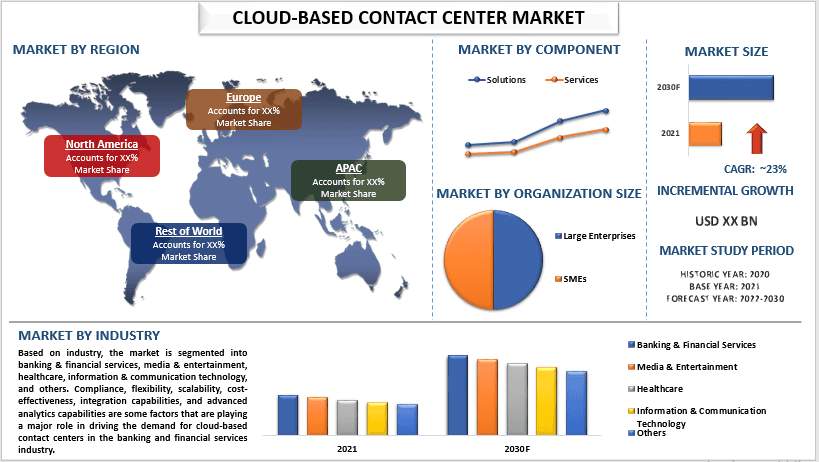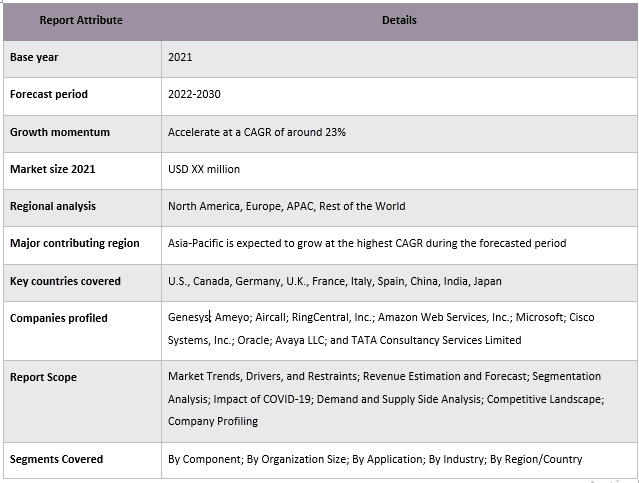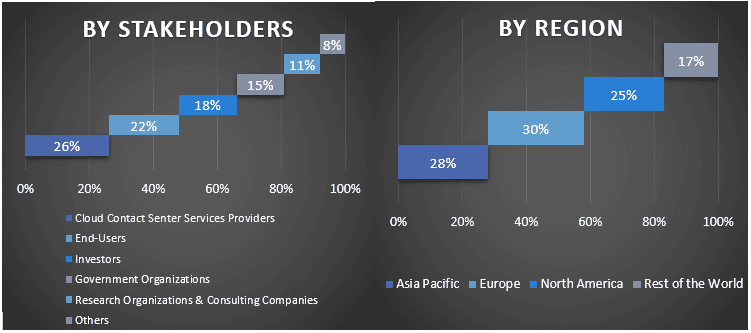- Home
- About Us
- Industry
- Services
- Reading
- Contact Us
Cloud-based Contact Center Market : Current Analysis and Forecast (2022-2030)
Emphasis on Component (Solutions and Services); Organization Size (Large Enterprises and SMEs); Application (Interactive Voice Response, Automatic Call Distribution, Call Recording, Workforce Optimization, and Others); Industry (Banking & Financial Services, Media & Entertainment, Healthcare, Information & Communication Technology, and Others); and Region/Country

The Cloud-based Contact Center Market is expected to grow at a steady rate of around 23% owing to the growing need for personalized and streamlined customer interactions. A cloud-based contact center is a customer service platform that operates entirely in the cloud, rather than on-premise hardware or software. This type of contact center relies on remote servers and cloud technology to provide a range of features, including inbound and outbound call routing, interactive voice response, automatic call distribution, and customer relationship management. Because it is cloud-based, a contact center can be accessed from anywhere with an internet connection, allowing agents to work remotely from home or other locations. This flexibility is particularly beneficial for companies with geographically dispersed agents or those that require a rapid response to changing customer needs. Besides, cloud-based contact centers typically offer cost savings, scalability, and easy integration with other cloud-based business applications. Moreover, the increasing popularity of omnichannel contact centers to improve the availability of channels is one of the most prominent factors driving the growth of the market. Further on, the increasing investment in cloud-based contact center solutions providers is also contributing to the growth of the market. For instance, in July 2021, Zoom announced the acquisition of cloud contact center solution provider Five9 for about USD 14.7 billion.
Some of the major players operating in the market include Genesys; Ameyo; Aircall; RingCentral, Inc.; Amazon Web Services, Inc.; Microsoft; Cisco Systems, Inc.; Oracle; Avaya LLC; and TATA Consultancy Services Limited. Several M&As along with partnerships have been undertaken by these players to facilitate customers with hi-tech and innovative products/technologies.
Insights Presented in the Report
“Amongst component, the solutions segment held a significant share of the market in 2021”
Based on component, the market is bifurcated into solutions and services. The solutions segment held a prominent share of the market in 2021 and is expected to grow at a prominent CAGR during the forecasted period. This is because a cloud-based contact center allows businesses to build the exact solution needed through application programming interfaces (APIs) rather than adopting immutable hardware and software. Moreover, cloud-based contact centers also enable greater agent versatility, improve agent efficiency, reduce cost, and enhance security.
“Amongst application, the interactive voice response segment to grow at a substantial CAGR during the forecast period”
By application, the market is segmented into interactive voice response, automatic call distribution, call recording, workforce optimization, and others. The interactive voice response catered to a significant share of the global cloud-based contact center market in 2021 majorly due to the benefits it offers to the organizations such as efficient call routing, lower operational costs, error reduction, increased security, and others. Besides, IVR offers virtual receptionist and operator options to save labor costs and free up time for the service team. This allows better use of the resources while meeting the customers’ needs.
“North America dominated the market in 2021”
North America held the major share of the global cloud-based contact center market in 2021. The dominating share of North America can be largely attributed to the flexibility, scalability, cost-effectiveness, better accessibility, and mobility of cloud-based contact centers. Cloud-based solutions offer a flexible and scalable alternative to traditional on-premises systems. This scalability allows businesses to quickly adapt to changing call volume and customer needs, which is especially important in industries with high seasonality or unpredictable demand.
Cloud-based Contact Center Market Report Coverage

Reasons to buy this report:
- The study includes market sizing and forecasting analysis validated by authenticated key industry experts.
- The report presents a quick review of overall industry performance at one glance.
- The report covers an in-depth analysis of prominent industry peers with a primary focus on key business financials, product portfolios, expansion strategies, and recent developments.
- Detailed examination of drivers, restraints, key trends, and opportunities prevailing in the industry.
- The study comprehensively covers the market across different segments.
- Deep dive regional level analysis of the industry.
Customization Options:
The global cloud-based contact center market can further be customized as per the requirement or any other market segment. Besides this, UMI understands that you may have your own business needs, hence feel free to connect with us to get a report that completely suits your requirements.
Table of Content
Research Methodology for the Cloud-based Contact Center Market Analysis (2022-2030)
Analyzing the historical market, estimating the current market, and forecasting the future market of the global cloud-based contact center market were the three major steps undertaken to create and analyze the adoption of cloud-based contact centers in major regions globally. Exhaustive secondary research was conducted to collect the historical market numbers and estimate the current market size. Secondly, to validate these insights, numerous findings and assumptions were taken into consideration. Moreover, exhaustive primary interviews were also conducted, with industry experts across the value chain of the global cloud-based contact center market. Post assumption and validation of market numbers through primary interviews, we employed a top-down/bottom-up approach to forecasting the complete market size. Thereafter, market breakdown and data triangulation methods were adopted to estimate and analyze the market size of segments and sub-segments of the industry pertains to. Detailed methodology is explained below:
Analysis of Historical Market Size
Step 1: In-Depth Study of Secondary Sources:
Detail secondary study was conducted to obtain the historical market size of the cloud-based contact center market through company internal sources such as annual reports & financial statements, performance presentations, press releases, etc., and external sources including journals, news & articles, government publications, competitor publications, sector reports, third-party database, and other credible publications.
Step 2: Market Segmentation:
After obtaining the historical market size of the cloud-based contact center market, we conducted a detailed secondary analysis to gather historical market insights and share for different segments & sub-segments for major regions. Major segments are included in the report as component, organization size, application, and industry. Further country-level analyses were conducted to evaluate the overall adoption of testing models in that region.
Step 3: Factor Analysis:
After acquiring the historical market size of different segments and sub-segments, we conducted a detailed factor analysis to estimate the current market size of the cloud-based contact center market. Further, we conducted factor analysis using dependent and independent variables such as component, organization size, application, and industry of the cloud-based contact center market. A thorough analysis was conducted for demand and supply-side scenarios considering top partnerships, mergers and acquisitions, business expansion, and product launches in the cloud-based contact center market sector across the globe.
Current Market Size Estimate & Forecast
Current Market Sizing: Based on actionable insights from the above 3 steps, we arrived at the current market size, key players in the global cloud-based contact center market, and market shares of the segments. All the required percentage shares split, and market breakdowns were determined using the above-mentioned secondary approach and were verified through primary interviews.
Estimation & Forecasting: For market estimation and forecast, weights were assigned to different factors including drivers & trends, restraints, and opportunities available for the stakeholders. After analyzing these factors, relevant forecasting techniques i.e., the top-down/bottom-up approach were applied to arrive at the market forecast for 2030 for different segments and sub-segments across the major markets globally. The research methodology adopted to estimate the market size encompasses:
- The industry’s market size, in terms of revenue (USD) and the adoption rate of the cloud-based contact center market across the major markets domestically
- All percentage shares, splits, and breakdowns of market segments and sub-segments
- Key players in the global cloud-based contact center market in terms of products offered. Also, the growth strategies adopted by these players to compete in the fast-growing market
Market Size and Share Validation
Primary Research: In-depth interviews were conducted with the Key Opinion Leaders (KOLs) including Top Level Executives (CXO/VPs, Sales Head, Marketing Head, Operational Head, Regional Head, Country Head, etc.) across major regions. Primary research findings were then summarized, and statistical analysis was performed to prove the stated hypothesis. Inputs from primary research were consolidated with secondary findings, hence turning information into actionable insights.
Split of Primary Participants in Different Regions

Market Engineering
The data triangulation technique was employed to complete the overall market estimation and to arrive at precise statistical numbers for each segment and sub-segment of the global cloud-based contact center market. data was split into several segments & sub-segments post studying various parameters and trends in the areas of the component, organization size, application, and industry in the global cloud-based contact center market.
The main objective of the Global Cloud-based Contact Center Market Study
The current & future market trends of the global cloud-based contact center market were pinpointed in the study. Investors can gain strategic insights to base their discretion for investments on the qualitative and quantitative analysis performed in the study. Current and future market trends determined the overall attractiveness of the market at a regional level, providing a platform for the industrial participant to exploit the untapped market to benefit from a first-mover advantage. Other quantitative goals of the studies include:
- Analyze the current and forecast market size of the cloud-based contact center market in terms of value (USD). Also, analyze the current and forecast market size of different segments and sub-segments
- Segments in the study include areas of the component, organization size, application, and industry
- Define and analysis of the regulatory framework for the cloud-based contact center industry
- Analyze the value chain involved with the presence of various intermediaries, along with analyzing customer and competitor behaviors of the industry
- Analyze the current and forecast market size of the cloud-based contact center market for the major region
- Major countries of regions studied in the report include Asia Pacific, Europe, North America, and the Rest of the World
- Company profiles of the cloud-based contact center market and the growth strategies adopted by the market players to sustain in the fast-growing market
- Deep dive regional level analysis of the industry
Related Reports
Customers who bought this item also bought










